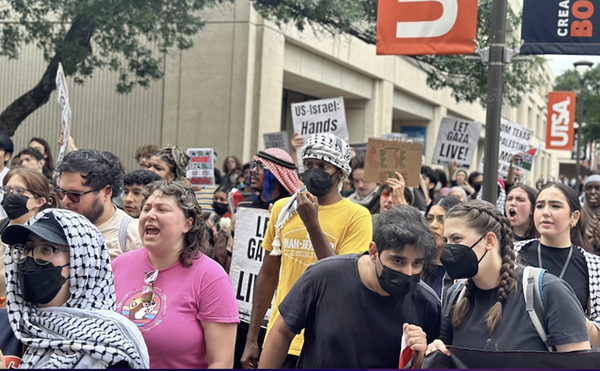“I don’t want a black wreath.”
Agosto Cuellar, owner of Jive Refried Vintage, hung up his antique phone, a replica of a ’70s Budweiser can. Calls were pouring in while Cuellar prepared for his last First Friday in the Southtown space he’s called home since 1999.
For over a decade his rock ’n’ roll boutique has been a stomping ground for creative types looking to meet like-minded artists. As the streets outside swirled with the foot traffic of the monthly First Friday art walk, Jive was packed with shoppers and longtime fans coming to pay their respects.
Amber Martinez, 19, says she comes for the great clothes and great people. “I love that Agosto gives young people a place to figure out who they are, and where they’re going.” The shop has always been about more than clothes — Cuellar loves to recount stories about the characters who wander into Jive, like “Glenda The Good Witch” and “Roberta, The One-Penny Song Girl,” who will compose a ditty, including your name, for a single red cent.
However, faced with eviction for what he says was his first-ever tardy rent payment, Cuellar laments the way neighborhood politics have changed the original character of the strip. “I’m one of the last few Latino merchants on this street,” Cuellar said. “Back in the late ’90s, we were a force. But year by year, the people who own the land have decided that we are no longer useful and we need to move on.”
In the case of Jive, which will remain open until July 23, Cuellar has also felt the pinch of steadily escalating rent as the area has developed. “I had a really good run here but its come to a point where I can no longer afford to pay the rent that they’re asking.”
In the early days of Jive more than a decade ago, “First Friday was just picking up, Blue Star [Arts Complex] had just gotten their wings to fly to become the success that it’s become, and we found our way in all of that chaos,” he said. The store sat right in the heart of Southtown, a place where offbeat attractions lure people in from across the city. South Alamo, the district’s premiere corridor, runs through the heart of the historic King William district, where some of the city’s highest property values are found. What ties it all together is art — expressed in the murals, mosaics, and the beautifully restored homes. But First Friday, the area’s most prominent art-centric event, has also become a flash point for disagreement between business operators and residents of the upscale community. In the beginning, live music flowed, vendors hawked freely, and food was sold and consumed street fair-style. But eventually, the intense popularity of “the weed that grew flowers,” as Cuellar calls it, reached a crisis point.
When the noise and the public drinking finally became too much for the neighbors, whose homes back up against South Alamo, there was a crackdown. In 2005, and again in 2008, the Current reported on the specter of hysteria surrounding First Friday, regarding “gang activity,” underage drinking, and public urination. “There were helicopters and cameras everywhere,” Cuellar said.
Now, he says, “there’s fewer people, the art has diminished, and restaurants have taken over the traffic. We used to do very well on First Friday but in recent years business has gone down.”
Dick Davis, the president of the King William Association, describes the neighborhood as “a sort of a museum, and we’re all a part of the fabric of taking care of it.” He’s witnessed the transformation of the district from a pioneering outpost to a gentrified gold mine. Davis bought his fixer-upper 34 years ago for $25,000 and he says that it’s now appraised at 20 times that value. (But, he cautions, that’s after investing plenty of “sweat equity.”)
Davis considers himself a peacekeeper. A staid man with a South Texas tan, he views the tensions between neighbors and businesses as just a matter of misunderstanding. The King William Association provides a service to neighbors by keeping them informed via weekly email newsletters by and monthly meetings. “It fosters a community you rarely find in other neighborhoods. We keep people aware of things that are going on and we share information. It sparks a get-to-know-your-neighbor spirit ... which also leads people to get active on issues.”
Davis acknowledges that some residents do tend to become emotional when discussing issues like the sometimes-frenetic activity on the street, but that’s part of the territory with a highly involved and informed community.
Business is good just a few doors down from Jive at the Friendly Spot, where it seems the entire downtown crowd comes, by bike or on foot, at least a few times a week. Dogs and children abound, and tables full of people order specialty beers and Mexican snacks. And yet even such a family-friendly venue — where Cuellar can be found DJing frequently — isn’t immune from neighborhood pressures.
“We make too much noise and we have too much fun,” Cuellar said. “We’re in a constant battle with the neighborhood association in the fact that they don’t really understand what First Friday is about. ”
Frequent police calls about noise at the Friendly Spot by neighbors has put something of a damper on the good times. “I feel like my neighborhood has been hijacked,” said Jody Newman, co-owner of the Friendly Spot. In the last year and a half the police have been called to the ice house a total of 25 times, SAPD records show — though not a single citation has been issued. Newman says she also frequently gets what she calls threatening phone calls at her home.
The police calls are typically noise complaints or logged as “public disturbance.” But the Newmans know the letter of the law and their noise levels are well within the rights of such a commercially zoned space. But the harassment has led to them to feel unwelcome. They say they would not even attempt to open another business in the area due to the difficulty of appeasing the neighbors. Instead, they are considering opening a raspa stand on the North St. Mary’s strip.
Rene Guerrero of the Southtown Chamber of Commerce opened Madhatter’s Tea House a couple doors down from the Friendly Spot on Beauregard Street years ago, but he has since sold the business. He also says there’s a reason why new businesses are flocking to the Lavaca neighborhood, a few miles further south in Southtown, instead of King William. “There are so many hoops that small businesses have to jump through to get open — code compliance, mechanical, electrical — but in this neighborhood, you’ve got to jump through another hoop, and that’s called the King William Association.”
In the case of Oloroso, a seasonal fine-dining restaurant that opened on South Alamo in 2010, the lack of neighborhood support over the restaurant’s failure to secure dedicated parking made for a quick exit. Today, the building stands vacant, like several other economic casualties of the strip, such as Casbeers at the Church, despite the desirability of Southtown real estate.
Conflicts aside, the saving grace of King William is the influx of fresh blood. As bilingual Bonham Elementary has emerged as one of the city’s best schools, young families with children are moving into the area, and bringing their progressive attitudes with them.
Michael Girdley and his family, including two small children, have lived in King William for four years. “More than an owner, I consider myself a caretaker of my home,” he said of his 122-year-old residence.
Formerly a San Francisco resident, Girdley says the noise and parking issues don’t outweigh the positives that come with living in a vibrant and walkable urban neighborhood. “We don’t live in Stone Oak and we all chose not to live in Stone Oak for a reason. If everyone would relax a little everything would be okay.”
But if Southtown is going to recapture its more bohemian period, it will likely take a few more transplants like Girdley.
“They’ve taken away the vendors, the music, the fact that no one can drink anymore on the street, they’ve done it because they own land and they have money,” Cuellar said.
So while Cuellar leaves Jive behind to put redoubled energy into his fashion designs, watch for new storefronts to open … down the road in Lavaca and, possibly, across town on North St. Mary’s. •


















